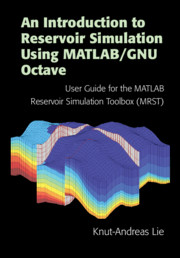 An Introduction to Reservoir Simulation Using MATLAB/GNU Octave
An Introduction to Reservoir Simulation Using MATLAB/GNU Octave Book contents
- Frontmatter
- Contents
- Preface
- 1 Introduction
- Part I Geological Models and Grids
- Part II Single-Phase Flow
- Part III Multiphase Flow
- Part IV Reservoir Engineering Workflows
- 13 Flow Diagnostics
- 14 Grid Coarsening
- 15 Upscaling Petrophysical Properties
- Appendix The MATLAB Reservoir Simulation Toolbox
- References
- Index
- Index
13 - Flow Diagnostics
from Part IV - Reservoir Engineering Workflows
Published online by Cambridge University Press: 22 July 2019
- Frontmatter
- Contents
- Preface
- 1 Introduction
- Part I Geological Models and Grids
- Part II Single-Phase Flow
- Part III Multiphase Flow
- Part IV Reservoir Engineering Workflows
- 13 Flow Diagnostics
- 14 Grid Coarsening
- 15 Upscaling Petrophysical Properties
- Appendix The MATLAB Reservoir Simulation Toolbox
- References
- Index
- Index
Summary
This chapter presents flow diagnostics methods you can use to delineate volumetric communications and improve your understanding of how flow patterns in the reservoir are affected by geological heterogeneity and respond to engineering controls. Using these methods, you can answer questions such as: to what region does a given injector provide pressure support? Which injection and production wells are in communication? Which parts of the reservoir affect this communication? How much does each injector support the recovery from a given producer? Do any of the wells have backflow? What is the sweep and displacement efficiency within a given drainage, sweep, or well-pair region? Which regions are likely to remain unswept? Flow diagnostics also provide several measures of the dynamic heterogeneity of a reservoir model, i.e., the variation in flow paths and their associated travel or residence times. We present several examples that demonstrate how you can use flow diagnostics to analyze interwell communication, improve well placement and sweep efficiency, and pre- and postprocess multiphase flow simulations.
Keywords
- Type
- Chapter
- Information
- An Introduction to Reservoir Simulation Using MATLAB/GNU OctaveUser Guide for the MATLAB Reservoir Simulation Toolbox (MRST), pp. 477 - 517Publisher: Cambridge University PressPrint publication year: 2019
- Creative Commons
- This content is Open Access and distributed under the terms of the Creative Commons Attribution licence CC-BY-NC-ND 4.0 https://creativecommons.org/cclicenses/


